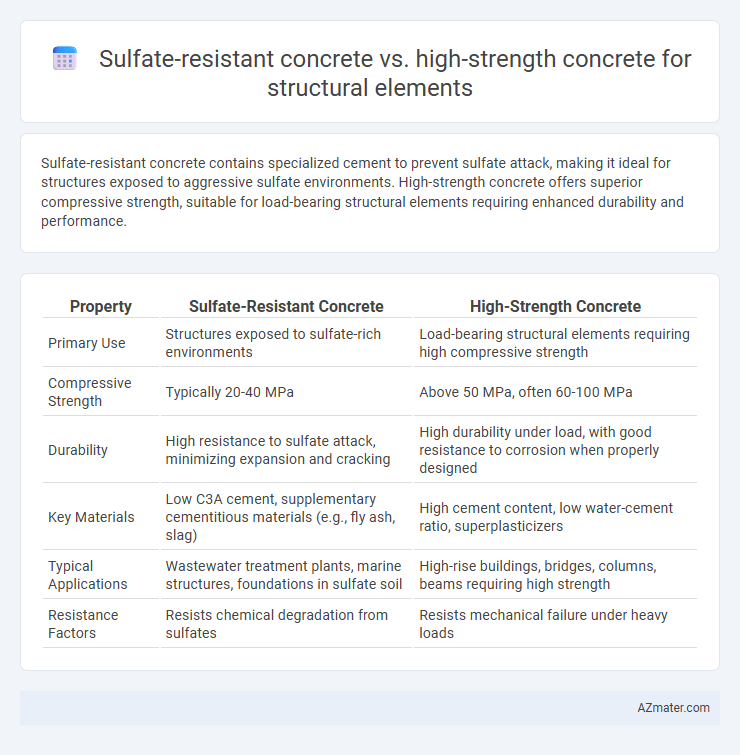Sulfate-resistant concrete contains specialized cement to prevent sulfate attack, making it ideal for structures exposed to aggressive sulfate environments. High-strength concrete offers superior compressive strength, suitable for load-bearing structural elements requiring enhanced durability and performance.
Table of Comparison
| Property | Sulfate-Resistant Concrete | High-Strength Concrete |
|---|---|---|
| Primary Use | Structures exposed to sulfate-rich environments | Load-bearing structural elements requiring high compressive strength |
| Compressive Strength | Typically 20-40 MPa | Above 50 MPa, often 60-100 MPa |
| Durability | High resistance to sulfate attack, minimizing expansion and cracking | High durability under load, with good resistance to corrosion when properly designed |
| Key Materials | Low C3A cement, supplementary cementitious materials (e.g., fly ash, slag) | High cement content, low water-cement ratio, superplasticizers |
| Typical Applications | Wastewater treatment plants, marine structures, foundations in sulfate soil | High-rise buildings, bridges, columns, beams requiring high strength |
| Resistance Factors | Resists chemical degradation from sulfates | Resists mechanical failure under heavy loads |
Introduction to Sulfate-Resistant and High-Strength Concrete
Sulfate-resistant concrete is specifically engineered to withstand sulfate ion attack from soil or groundwater, preventing deterioration in aggressive environments by using low C3A cement content and supplementary cementitious materials like fly ash or slag. High-strength concrete is designed to achieve compressive strengths typically above 6,000 psi through optimized mix design, reduced water-cement ratio, and the use of admixtures, enhancing load-bearing capacity in structural elements. Both types of concrete serve distinct structural needs: sulfate-resistant concrete prioritizes durability in sulfate-rich conditions, while high-strength concrete focuses on maximizing structural performance and load resistance.
Key Properties of Sulfate-Resistant Concrete
Sulfate-resistant concrete is specially formulated with low C3A content in cement to withstand sulfate attack, ensuring durability in aggressive soil or water environments. Its key properties include high chemical resistance, reduced permeability, and enhanced long-term strength retention, making it ideal for sewage tanks, foundations, and marine structures. Compared to high-strength concrete, sulfate-resistant concrete prioritizes durability against chemical attacks over compressive strength, balancing structural integrity with environmental resilience.
Key Properties of High-Strength Concrete
High-strength concrete (HSC) exhibits superior compressive strength typically above 6000 psi, achieved through optimized mix design and reduced water-cement ratio, making it ideal for load-bearing structural elements requiring durability and performance. Unlike sulfate-resistant concrete, which is specifically formulated to withstand aggressive sulfate environments by incorporating sulfate-resistant cement and supplementary cementitious materials, HSC focuses primarily on mechanical properties such as high modulus of elasticity, improved tensile strength, and low permeability. These key properties of HSC ensure enhanced structural integrity, reduced crack propagation, and increased lifespan of critical construction components in demanding applications.
Chemical Composition and Additives
Sulfate-resistant concrete contains low C3A (tricalcium aluminate) content, typically below 5%, minimizing its reactivity with sulfate ions and protecting structural elements in sulfate-rich environments. High-strength concrete features a higher cement content and incorporates pozzolanic additives such as silica fume, fly ash, or slag to enhance compressive strength and durability through a denser microstructure. The chemical composition of sulfate-resistant concrete prioritizes reduced aluminates, whereas high-strength concrete emphasizes optimized hydration and particle packing to achieve superior mechanical performance.
Durability in Aggressive Environments
Sulfate-resistant concrete is specifically formulated with low C3A content to combat sulfate attack, making it highly durable in aggressive environments such as sewage plants and marine structures. High-strength concrete, while possessing superior compressive strength often exceeding 6,000 psi, may not inherently offer resistance to sulfate-induced deterioration unless combined with sulfate-resistant materials. Selecting sulfate-resistant concrete ensures enhanced longevity and structural integrity in sulfate-rich conditions compared to conventional high-strength concrete.
Strength Performance and Load-Bearing Capacity
Sulfate-resistant concrete exhibits enhanced durability in aggressive environments by resisting chemical attacks from sulfates, maintaining its structural integrity over time. High-strength concrete delivers superior compressive strength, enabling higher load-bearing capacity essential for demanding structural elements. While sulfate-resistant concrete prioritizes chemical resistance and long-term durability, high-strength concrete focuses on maximizing strength performance to support greater structural loads.
Application Scenarios in Structural Elements
Sulfate-resistant concrete is ideal for structural elements exposed to aggressive sulfate-rich soils or groundwater, such as foundations, retaining walls, and sewage treatment plants, providing enhanced durability and preventing sulfate attack. High-strength concrete is preferred for columns, beams, and slabs in high-load-bearing structures like skyscrapers and bridges, offering superior compressive strength and reduced cross-sectional dimensions. Choosing between them depends on environmental conditions and load requirements, ensuring optimal performance and longevity of structural elements.
Cost Implications and Economic Considerations
Sulfate-resistant concrete typically incurs higher initial costs due to specialized materials like Type V cement or supplementary cementitious materials to prevent sulfate attack, making it essential for structures exposed to aggressive sulfate environments. High-strength concrete, designed to achieve greater compressive strength, often involves more expensive aggregates and admixtures but can reduce overall material volume and structural dimensions, potentially lowering long-term construction costs. Economic considerations should balance the upfront expense of sulfate resistance with durability benefits, while high-strength concrete may offer cost savings in reduced formwork and foundation requirements, emphasizing the importance of project-specific environmental and load demands for optimal cost efficiency.
Environmental Impact and Sustainability
Sulfate-resistant concrete reduces environmental impact by limiting the need for frequent repairs and replacements due to sulfate attack, enhancing the durability of structural elements in aggressive soil or water conditions. High-strength concrete offers sustainability benefits through reduced material usage for the same load-bearing capacity, lowering carbon emissions linked to cement production. Choosing sulfate-resistant concrete in sulfate-rich environments and high-strength concrete in load-intensive applications optimizes the longevity and environmental performance of structural elements.
Selection Criteria for Structural Projects
Selecting sulfate-resistant concrete over high-strength concrete is essential for structural elements exposed to aggressive sulfate environments to prevent chemical attack and ensure long-term durability. High-strength concrete is preferred when load-bearing capacity, compressive strength above 6,000 psi, and minimal deformation are critical for structural integrity. Project-specific factors such as sulfate exposure risk, required strength, durability expectations, and cost constraints guide engineers in choosing between these concrete types.

Infographic: Sulfate-resistant concrete vs High-strength concrete for Structural element
 azmater.com
azmater.com